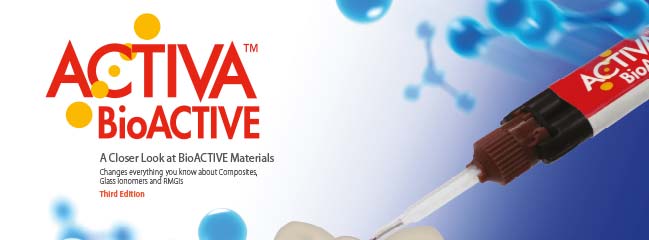Overview
Bioactive materials that behave favorably in the moist oral environment, neutralize conditions that cause dental caries, provide prevention benefits, and maximize the potential for remineralization will become the accepted standard of dental care.
ACTIVA BioACTIVE products are the first dental resins with a bioactive ionic resin matrix, shock-absorbing rubberized resin component, and reactive ionomer glass fillers that mimic the physical and chemical properties of natural teeth. These bioactive materials actively participate in the cycles of ionic exchange that regulate the natural chemistry of our teeth and saliva and contribute to the maintenance of tooth structure and oral health.
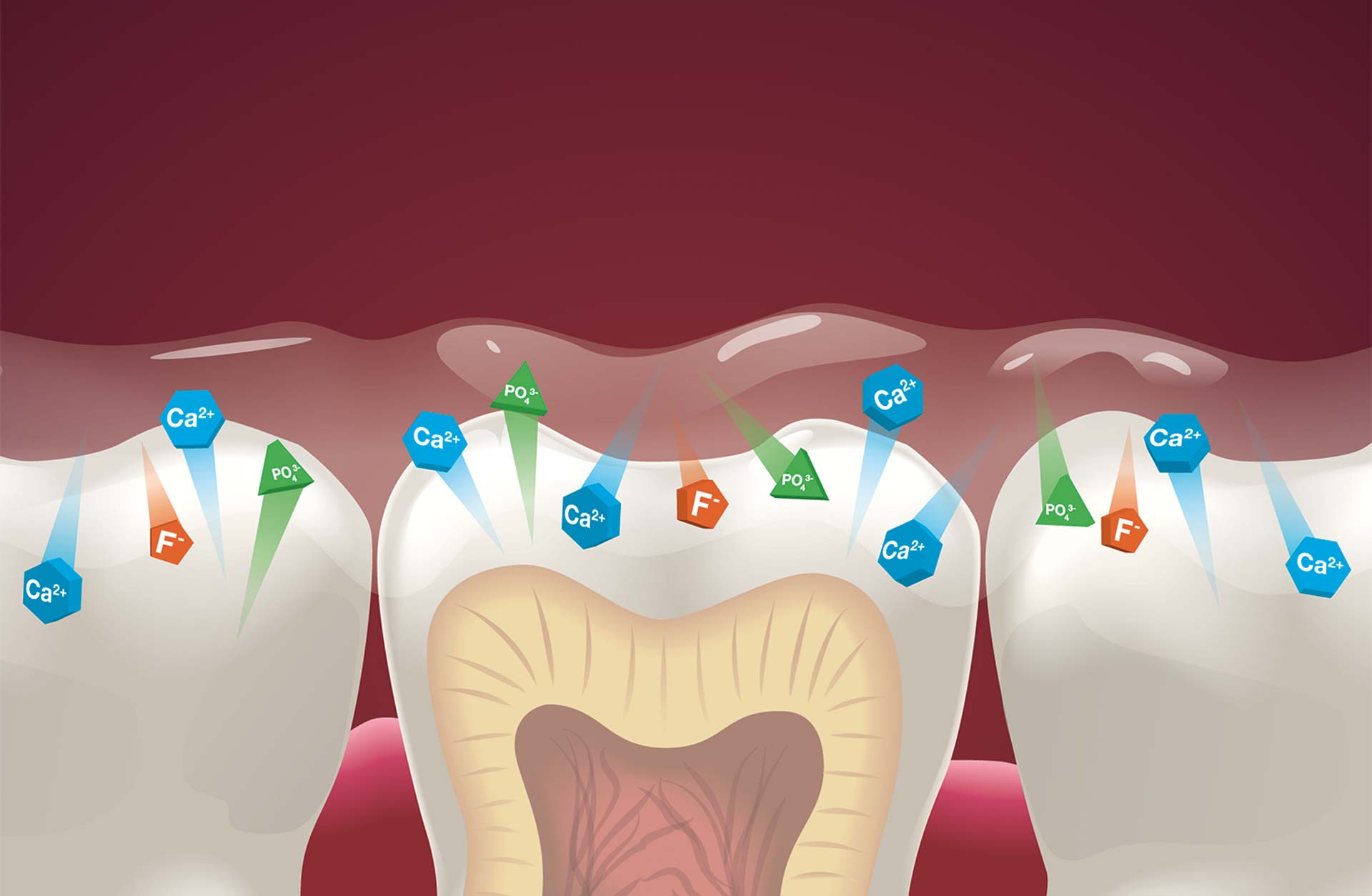
ACTIVA BioACTIVE has the strength, esthetics and physical properties of composites and is more bioactive than glass ionomers,1 combining the best attributes of both materials without compromising either one. ACTIVA BioACTIVE chemically bonds and seals teeth against microleakage,2,3 and its continuous release and recharge of significant amounts of calcium, phosphate and fluoride ions provide patients with long-term benefits.
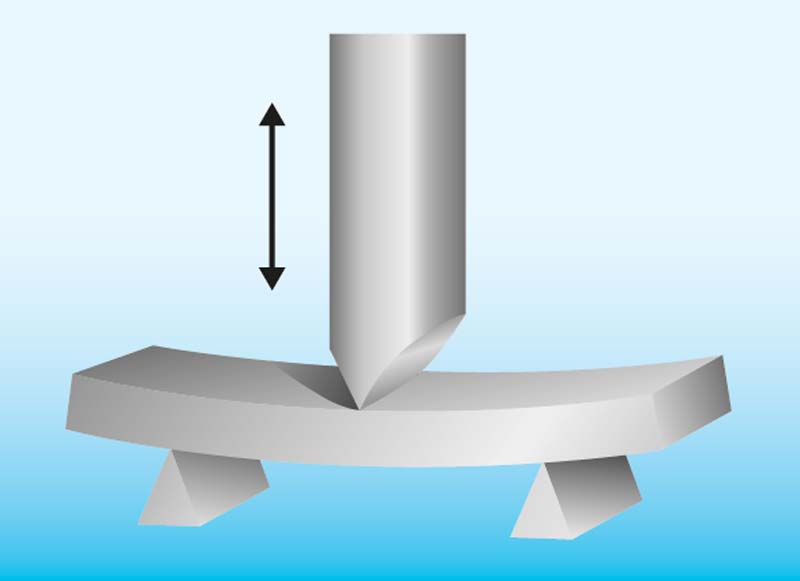
ACTIVA BioACTIVE products are tougher and more fracture resistant than composites. Toughness of ACTIVA BioACTIVE, measured by deflection at break, is 2-3 times greater than composites and 5-10 times greater than GIs and RMGIs.4,5,17
Unlike traditional materials that are hydrophobic, repel water, and are designed to be passive, ACTIVA BioACTIVE is an active, moisture friendly material that reacts to changes in the oral environment. Only moisture friendly materials that are partly water-based or have phases or zones with significant water content are capable of this dynamic behavior.6
ACTIVA BioACTIVE reacts to the continuous pH changes in the mouth to help fortify and recharge the ionic properties of saliva, teeth and the material itself.1,7,9 For this reason, ACTIVA BioACTIVE is considered a “smart” material.
ACTIVA BioACTIVE contains water, yet the material has extremely low solubility.8,20 The ionic resin matrix facilitates the diffusion of calcium, phosphate and fluoride ions while still maintaining the excellent physical properties associated with resins and composites.
ACTIVA BioACTIVE products contain no Bisphenol A, no Bis-GMA and no BPA derivatives. They are two-paste, automix systems with three setting mechanisms: light cure, self-cure resin chemistry, and self-cure glass ionomer reaction.
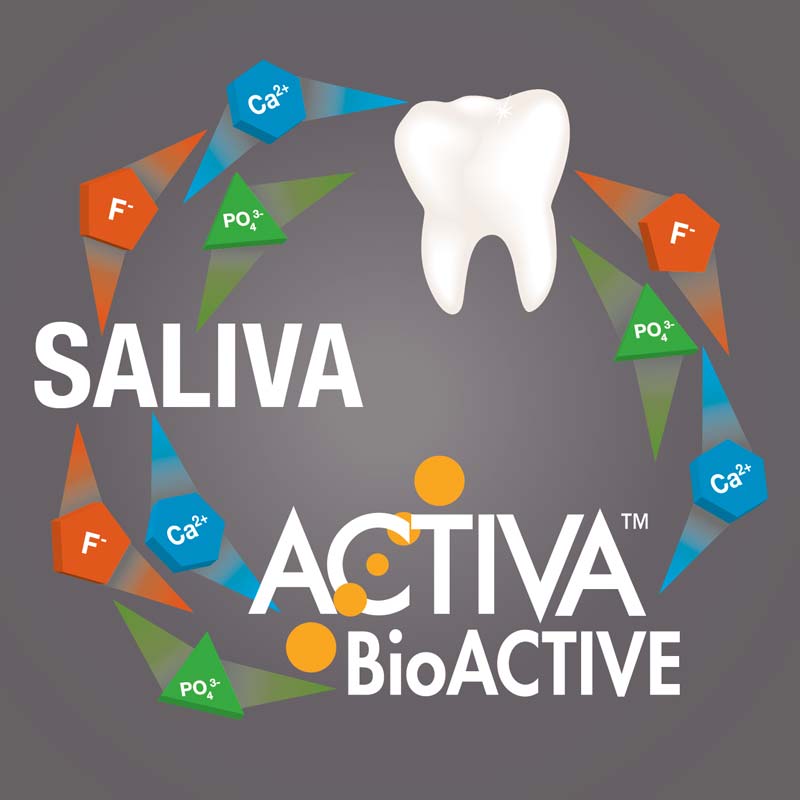
Bioactive Materials
Bioactive materials that are strong, esthetic and long-lasting offer an alternative to traditional composites, that are strong and esthetic but are passive and without bioactive potential materials, and to glass ionomers, that are bioactive but have poor esthetics and undesirable physical properties.
The development of bioactive materials is inspired by nature, where water is the source of life. In the oral cavity, saliva is the life source and is rich with water, proteins and ionic components.
Saliva is a natural caries protection agent and contains the minerals that maintain the integrity of the enamel surface. It helps maintain the health of hard and soft tissues, removes waste, and is the first line of defense against microbial invasion.
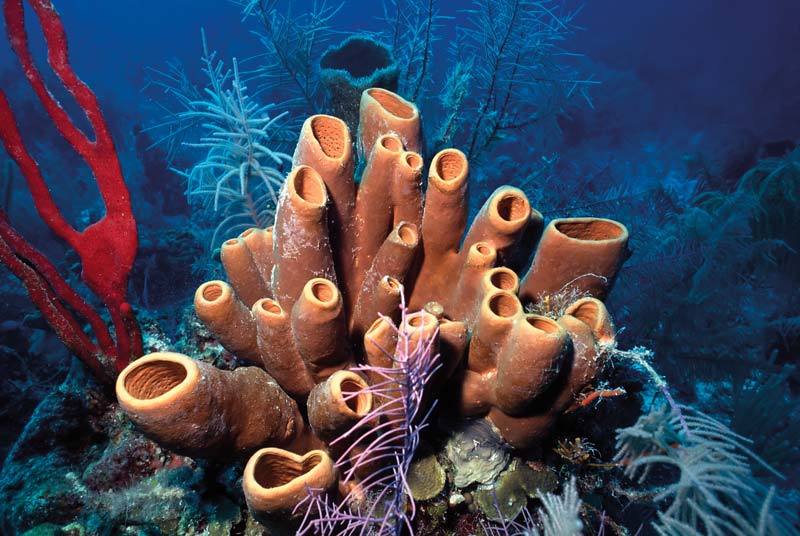
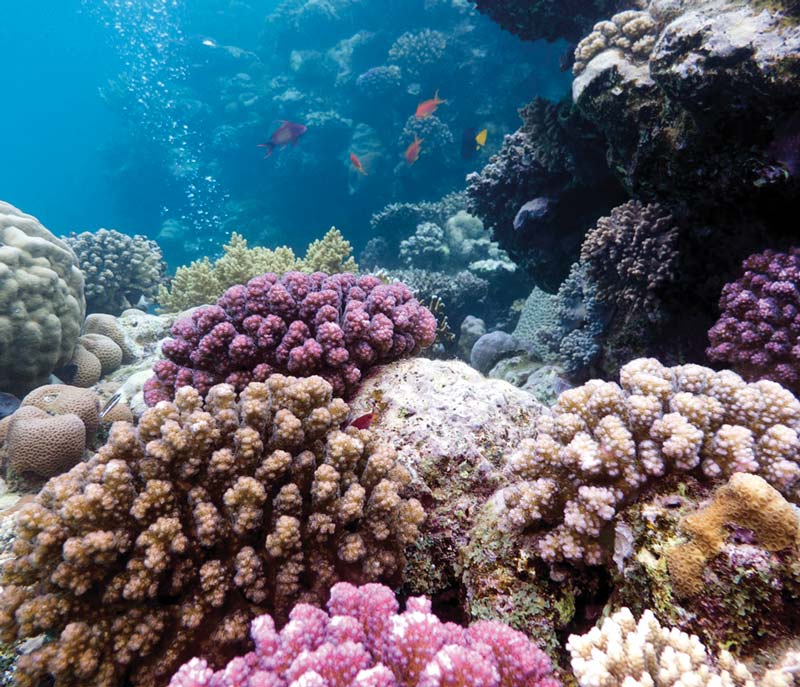
The oral environment is exposed to continuous pH cycles, and saliva and tooth structure participate in an endless cycle of mineral exchange. When the pH is low, the demineralization process releases calcium and phosphate ions from the tooth surface. As the pH rises, these ions are available to interact with fluoride ions in our saliva.
Bioactive materials imitate nature and participate in this dynamic ionic exchange. They are water-based or contain zones or phases of water and continuously release and recharge their ionic components. They react to the changes in the oral environment to bring about advantageous changes in the properties of saliva and the materials themselves. This is often referred to as “smart” behavior.6
Ionic Resins
ACTIVA BioACTIVE products are formulated with a patented, moisture friendly ionic-resin (Embrace resin) that contains a small amount of water. It is bioactive, mimics nature and responds to changes in the oral environment.9
The ionic resin exhibits exceptional marginal integrity, sealing ability against microleakage, and intimate adaptation to tooth structure.2,3,10 It releases a great amount of phosphate11 and significantly recharges with fluoride,1,7,11 and contains an acidic monomer12,13 that improves the interaction between the resin component and the glass ionomer and enhances the interaction with tooth structure.
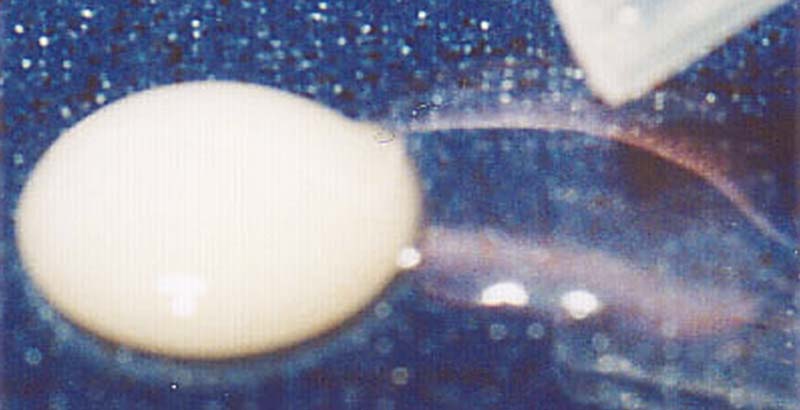
Fig. 1 A drop of water is placed next to uncured Embrace resin
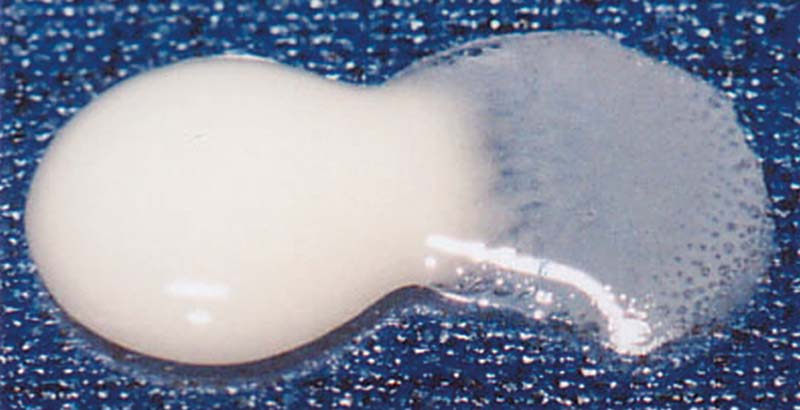
Fig. 2 Embrace mixes with the water
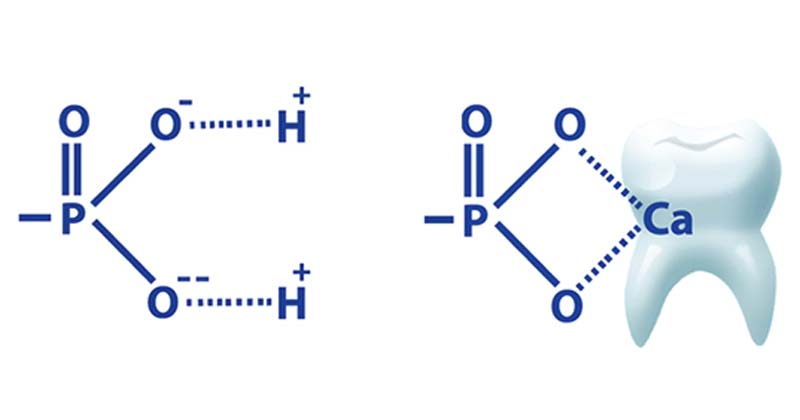
Fig 1: In the presence of saliva, hydrogen breaks off from the phosphate acid groups.
Fig 2: The hydrogen is replaced by calcium in the tooth, chemically bonding the resin to the tooth structure and forming an intimate seal.
The ionic resin contains phosphate acid groups. Through an ionization process that is dependent upon water, hydrogen ions break off from these groups and are replaced by calcium in tooth structure. This ionic interaction binds the resin to the minerals in the tooth, forming a strong resin-hydroxyapatite complex and a positive seal against microleakage.2,3,14.15,16,19
ACTIVA BioACTIVE participates in a dynamic system of ion exchange with saliva and tooth structure, continuously releasing and recharging calcium, phosphate and fluoride ions and reacting to pH changes in the mouth.1,7,9,11
Traditional Restorative Materials
Composites, Glass Ionomers and RMGIs
Traditional restorative materials have either great esthetics and physical properties or bioactivity. None of them have both. ACTIVA BioACTIVE products are the first dental materials to combine the benefits of composites, glass ionomers and RMGIs without their disadvantages.
Composites
are strong, highly esthetic filled resins
but due to poor adaptation to tooth structure, they have a high failure rate and last an average of 5.7 years. 21,22,23,24,25 They are not bioactive, release a minimal amount of fluoride, and do not bond chemically to teeth. Composites are hydrophobic, leak at the margins, are somewhat brittle in thin areas, can cause sensitivity, and promote MMPs. Staining at the margins is the first sign of failure. Most composites contain Bis-GMA, a derivative of Bisphenol A (BPA).
Glass ionomers
are bioactive
They release considerable amounts of fluoride, do not cause sensitivity, and form chemical bonds to tooth structure to seal against bacterial leakage. Their disadvantages include poor esthetics, poor longevity, brittleness, low strength, sensitivity to moisture, and high solubility and wash out.
Resin-modified glass ionomers (RMGIs)
incorporate reactive ionomer glass in a resin matrix
The advantages over glass ionomers are longer working time, controlled setting time, fast development of strength, lower sensitivity to environmental moisture changes, and improved esthetics and durability. RMGIs are bioactive like glass ionomers, but their esthetics and physical properties do not compare with composites.
Traditional glass ionomers and RMGIs are noted for low tensile strength, brittleness, and low resistance to wear, and this precludes their clinical use in some load-bearing, long-term clinical situations.26
Strength
Compressive and Diametral Tensile Strength of ACTIVA BioACTIVE-RESTORATIVE is comparable to composites and far superior to glass ionomers and RMGIs.
Filtek = Composite / ACTIVA BioACTIVE = BioACTIVE Restorative / Ketac Nano = RMGI / Fuji IX = GI
Filtek, Ketac Nano and Fuji IX are trademarks of 3M ESPE, 3M ESPE and GC respectively.
Source: University testing17
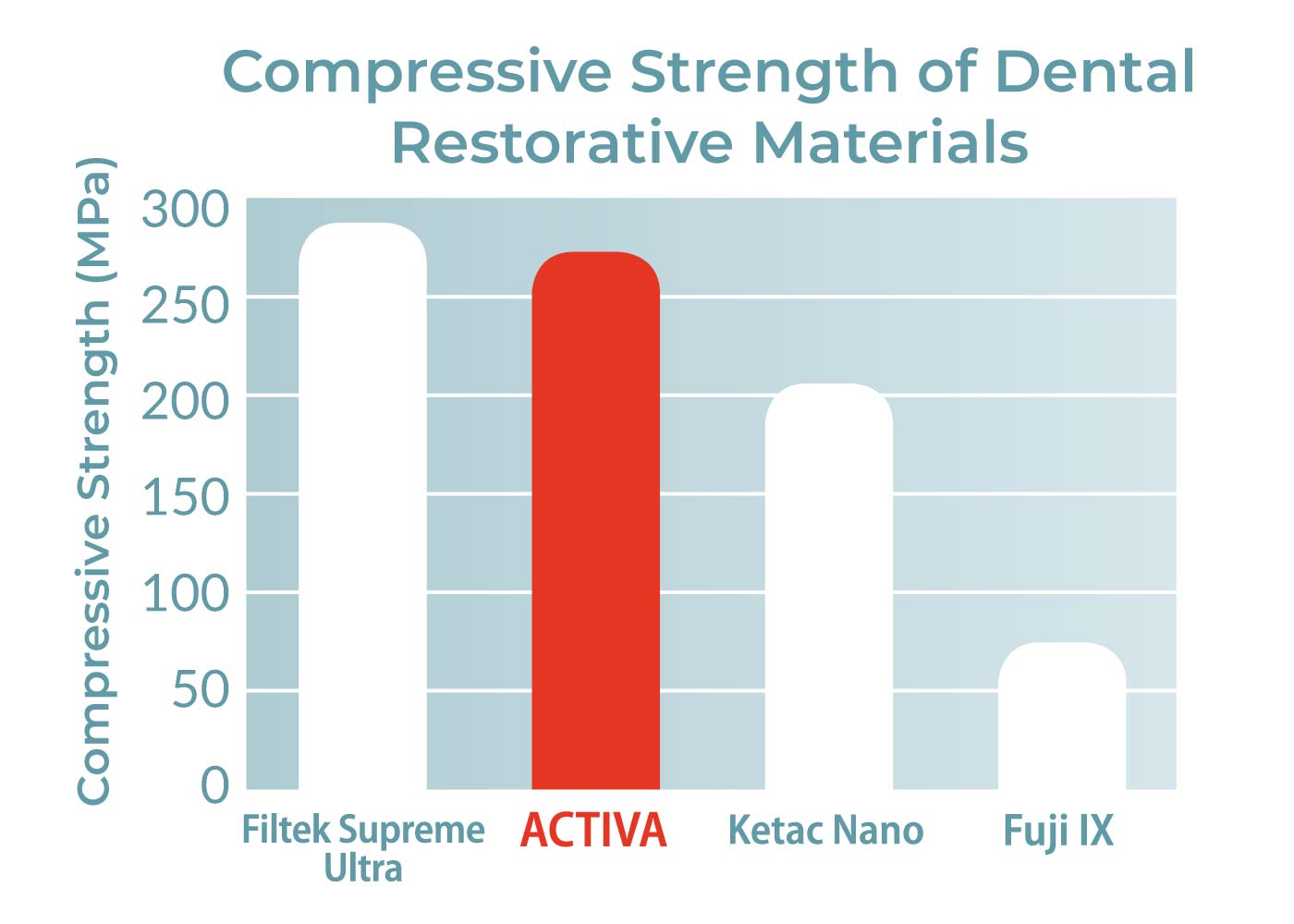
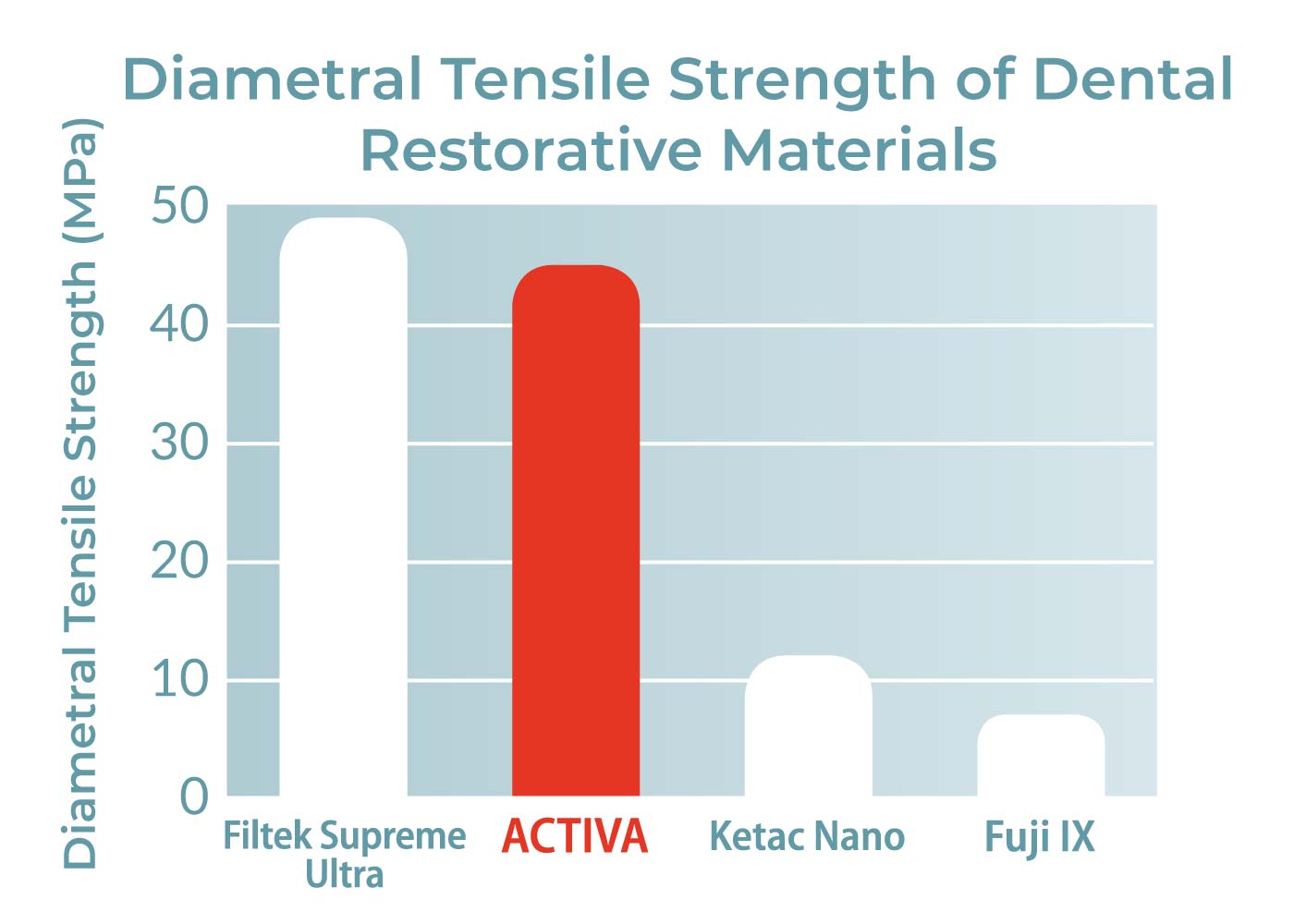
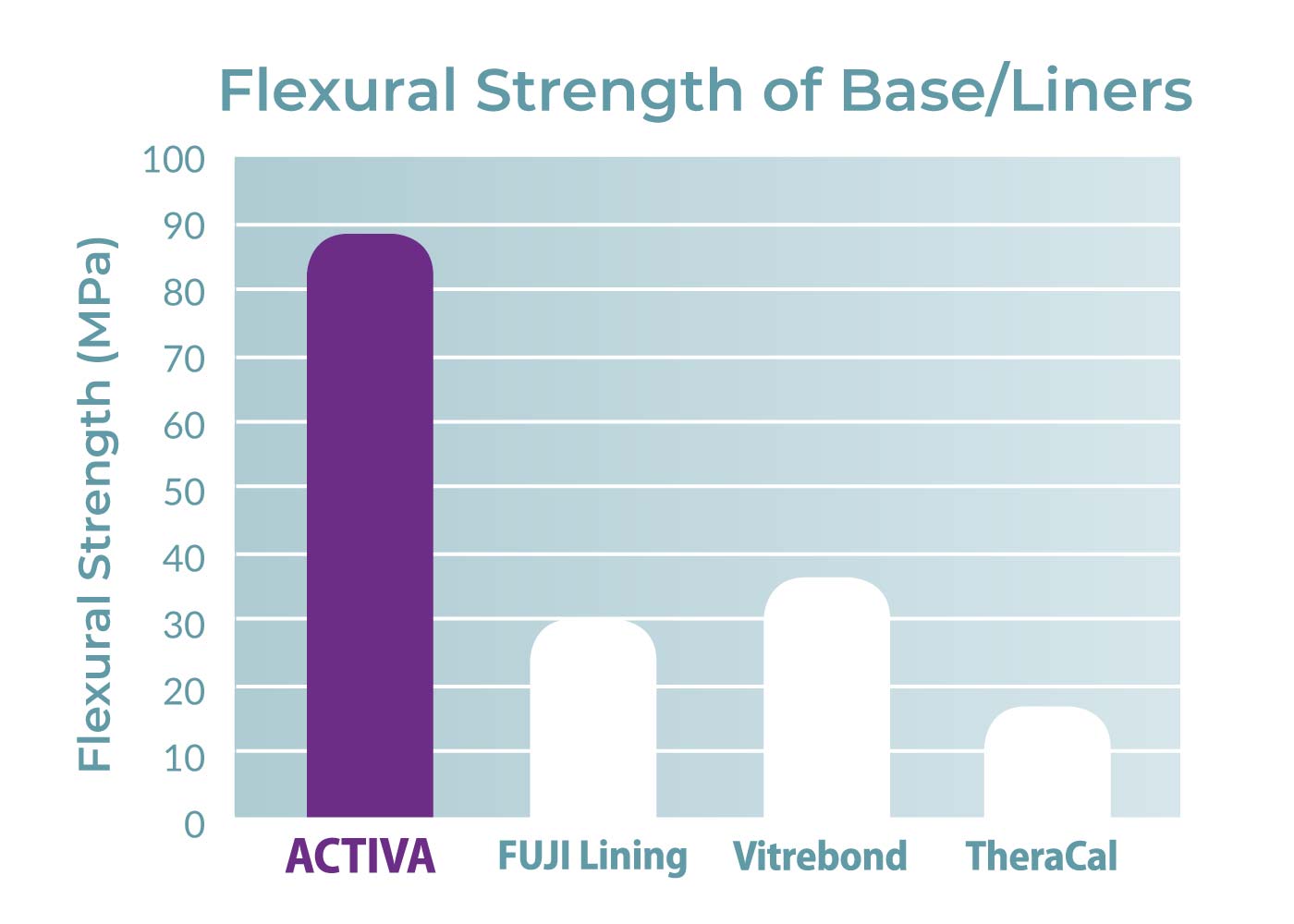
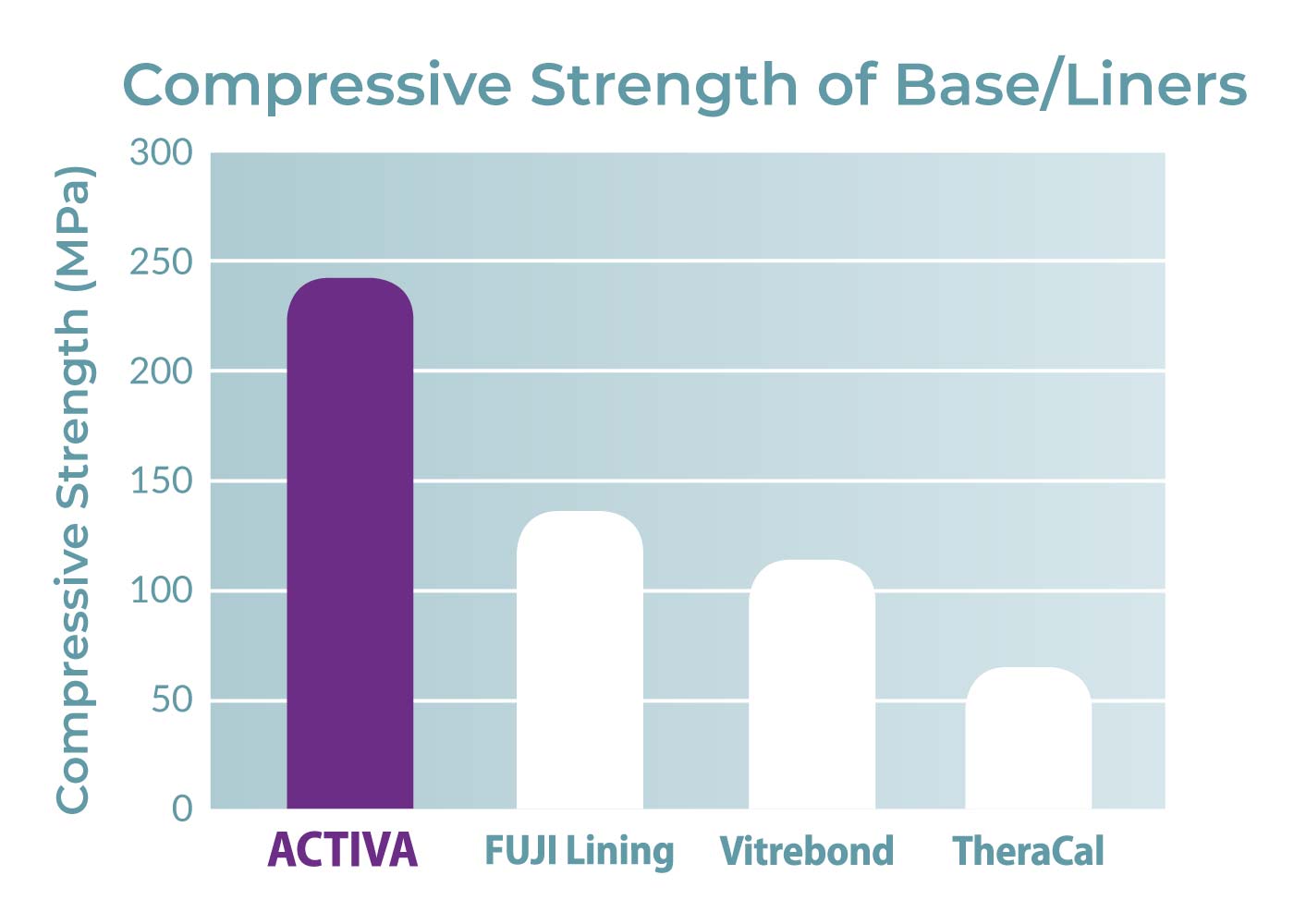
Compressive and Flexural Strength of ACTIVA BioACTIVE-BASE/LINER is much greater than resin-modified base/liners and RMGIs.
ACTIVA BioACTIVE = BioACTIVE Base/Liner; Fuji Lining & Vitrebond = RMGI
TheraCal = Resin-Modified Calcium Silicate
Fuji Lining, Vitrebond and TheraCal are trademarks of GC, 3M and Bisco respectively
Source: Pulpdent testing18
Shear bond strength of ACTIVA BioACTIVE-CEMENT compares favorably with leading cements and is superior to resin modified glass ionomer and calcium aluminate-glass ionomer cements tested.
ACTIVA BioACTIVE = Bioactive Cement; RelyX Unicem Automix = Self-adhesive Cement; FujiCEM2 = RMGI; Ceramir = Calcium Aluminate-GI
Source: University testing38
RelyX, FujiCEM and Ceramir are trademarks of 3M ESPE, GC and Doxa respectively.
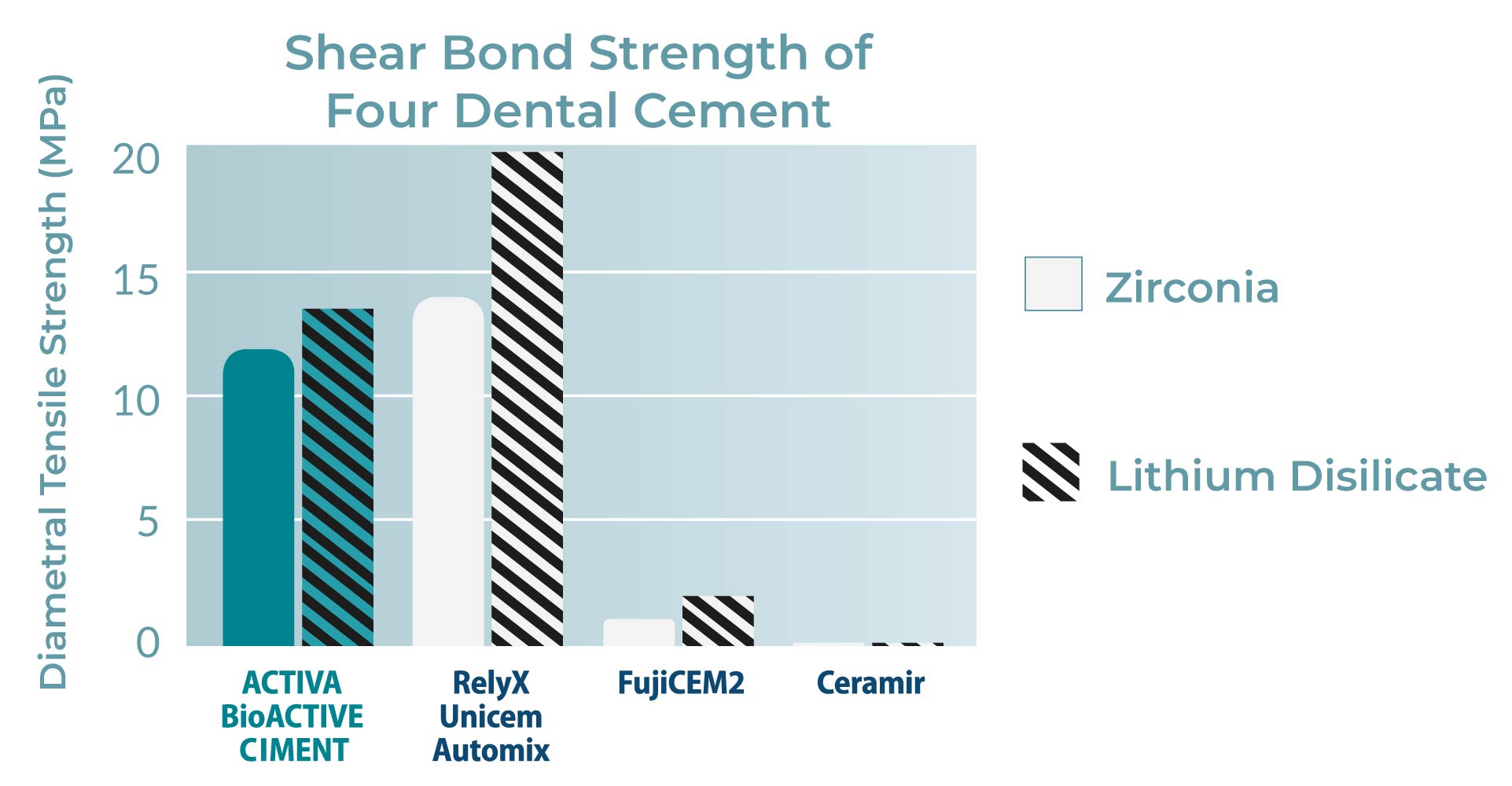
Wear
Volume wear of ACTIVA BioACTIVE-RESTORATIVE is comparable to composites and far less than glass ionomer.
Fuji IX = Glass Ionomer / ACTIVA BioACTIVE = Bioactive Restorative / Tetric = Composite / Filtek Supreme = Composite
Fuji IX, Tetric and Filtek are trademarks of GC, Ivoclar Vivadent and 3M ESPE respectively.
Source: University testing 27
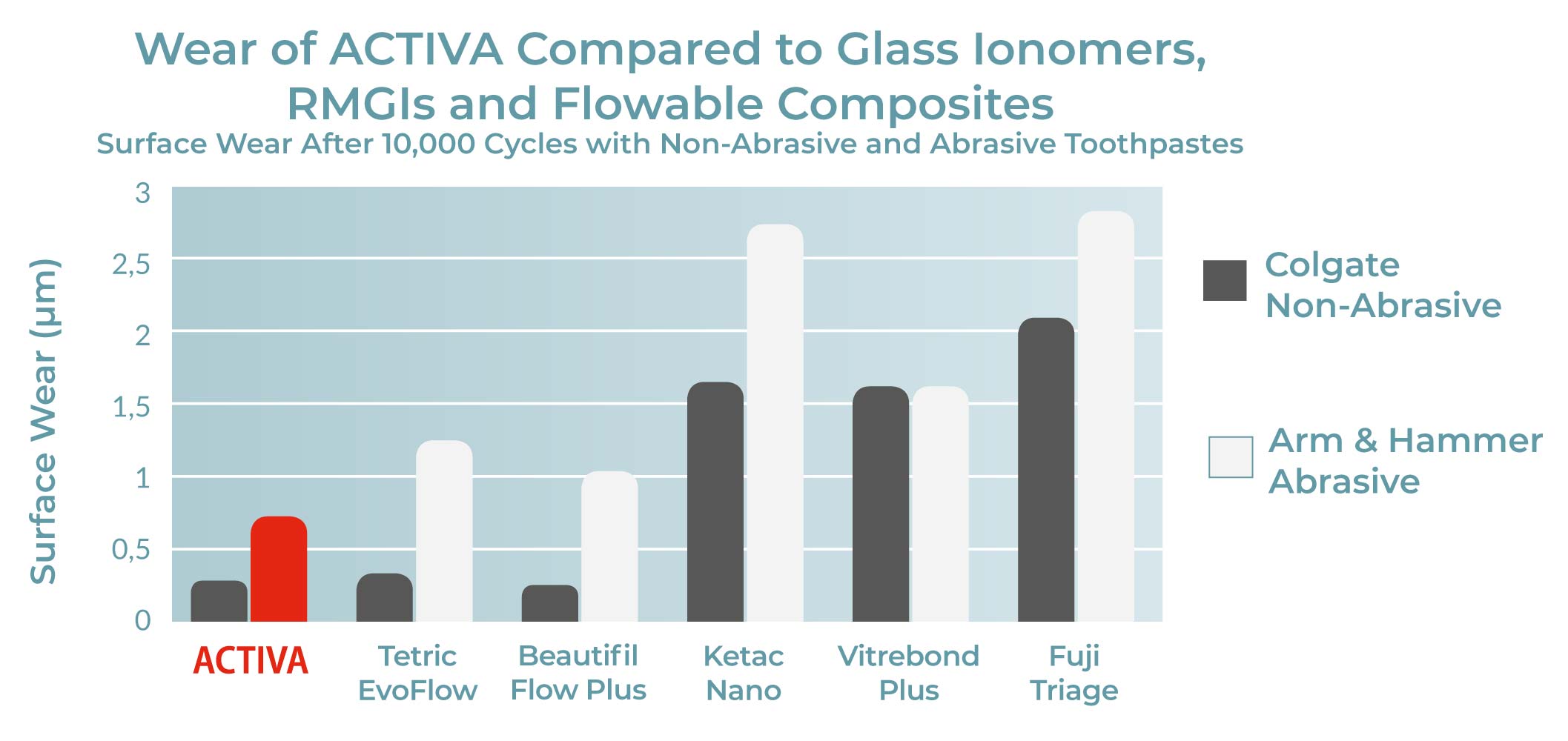
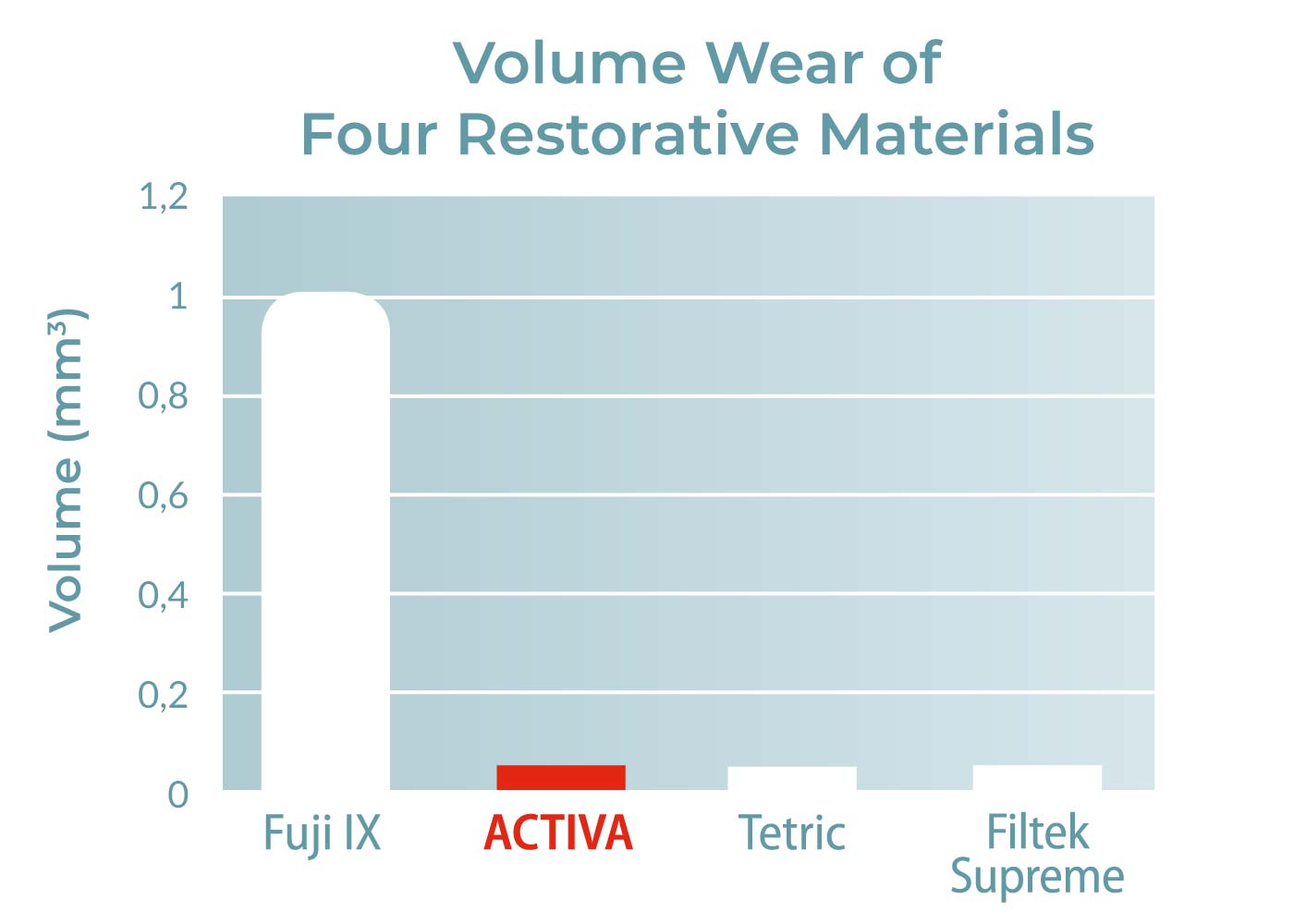
When evaluated for surface wear resistance, ACTIVA BioACTIVE-RESTORATIVE performed better than all other materials tested with abrasive toothpaste and was comparable to flowable composites with non-abrasive toothpaste.
ACTIVA BioACTIVE = Bioactive Restorative / Tetric EvoFlow and Beautifil Flow Plus = Flowable Composite / Ketac Nano and Vitrebond Plus = RMGI / Fuji Triage = Glass Ionomer
Tetric EvoFlow, Beautifil, and Fuji Triage are trademarks of Ivoclar Vivadent, Shofu, and GC respectively. Ketac and Vitrebond are trademarks of 3M ESPE. Source: University testing 28
Toughness, Fatigue Limit, Deflection at Break
ACTIVA BioACTIVE’s rubberized resin component provides unparalleled toughness and resilience. Toughness, measured by deflection at break using a 3-point bend test, is the ability of a strong, hard material to absorb stress, dissipate forces and resist fracture when a load is applied. Fatigue limit is determined by the incremental load required to cause fracture within a defined number of cycles The diagram shows a load applied to a hard material in a the 3-point bend test.
ACTIVA BioACTIVE samples far outperform all leading restorative materials tested for toughness. Deflection at Break of ACTIVA BioACTIVE is 2-3 times greater than composites and 5-10 times greater than GIs and RMGIs.
Fig. 1 Illustration shows 3-point bend test
Fig. 2 Filtek = Composite; ACTIVA BioACTIVE = BioACTIVE Restorative; Ketac Nano = RMGI; Fuji IX = GI
Filtek, Ketac Nano and Fuji IX are trademarks of 3M ESPE, 3M ESPE and GC respectively
Source: University testing5,17
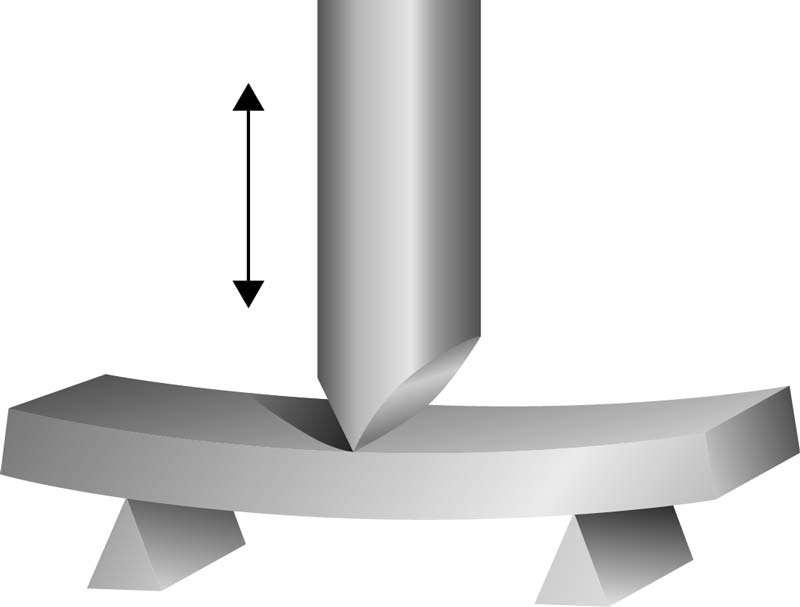
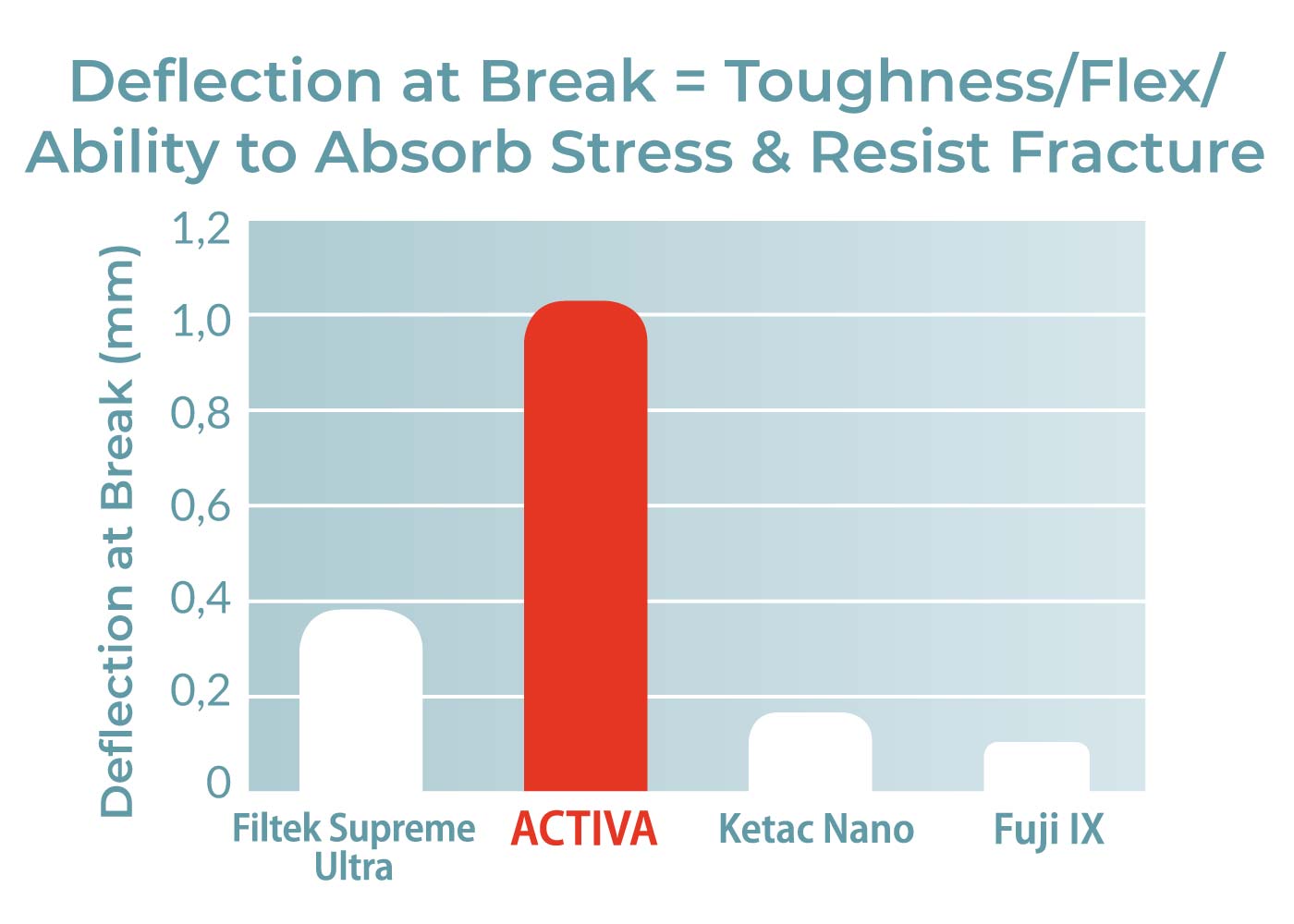
Deflection at break of ACTIVA BioACTIVE-CEMENT is significantly greater than that of other leading materials tested and acts like a ligament to absorb stress and resist fracture and chipping.
ACTIVA BioACTIVE = Bioactive Cement; RelyX Unicem Automix = Self-adhesive Cement; FujiCEM2 = RMGI; Ceramir = Calcium Aluminate-GI
RelyX, FujiCEM and Ceramir are trademarks of 3M ESPE, GC and Doxa respectively.
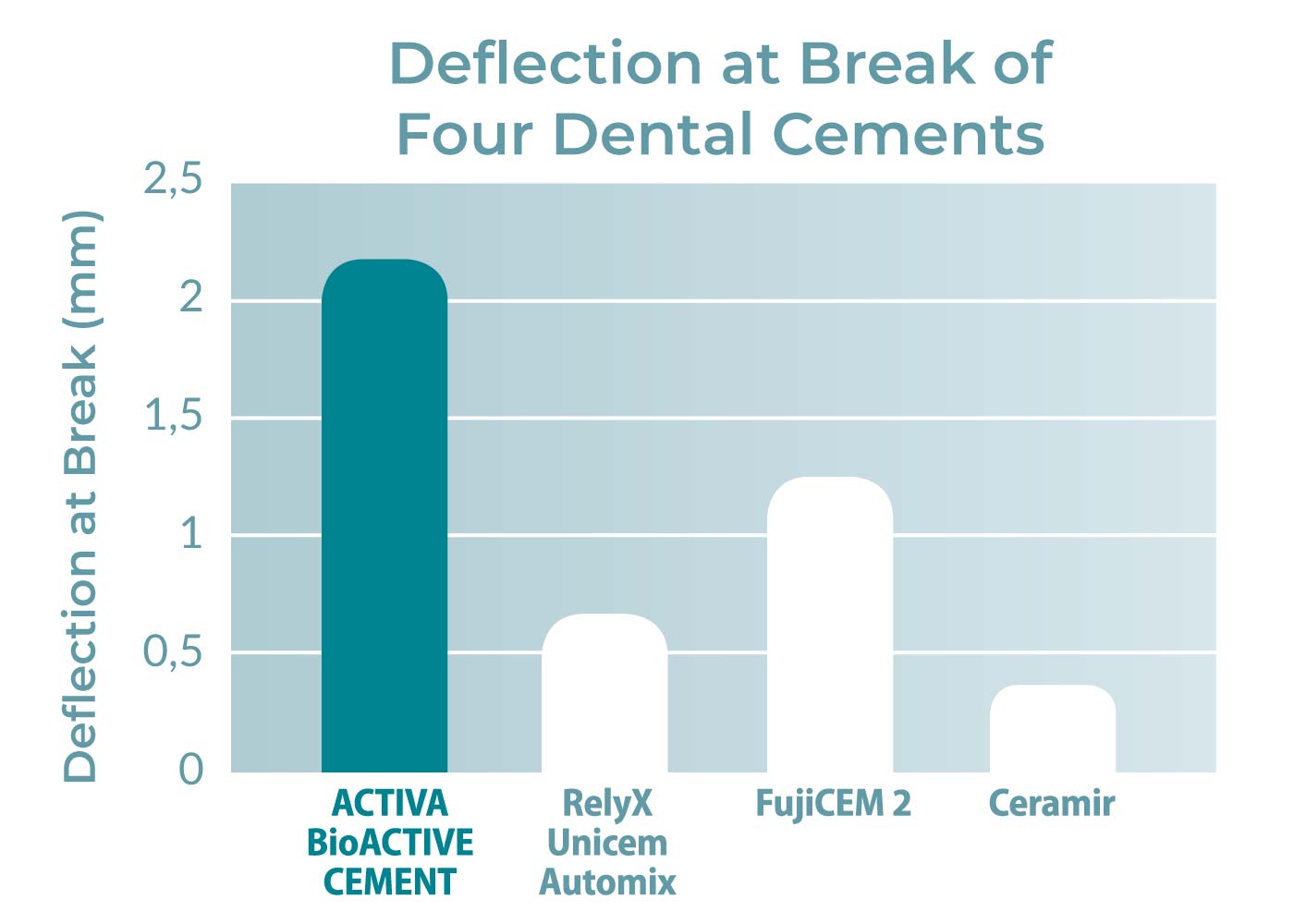
Water Absorption
A controlled and relatively low level of water absorption is advantageous for bioactive materials, which require water to unlock their bioactive properties and potential for ionic exchange. Excessive water absorption can compromise the physical properties of restorative and base/liner materials over time.
Water absorption of ACTIVA BioACTIVE-RESTORATIVE is designed to be slightly higher than composites, which are hydrophobic and not bioactive, and is significantly less than glass ionomers and RMGIs.
ACTIVA BioACTIVE = BioACTIVE Restorative; Filtek Supreme Ultra = Composite; Ketac Nano = RMGI, Fuji IX = GI; Fuji II LC = RMGI
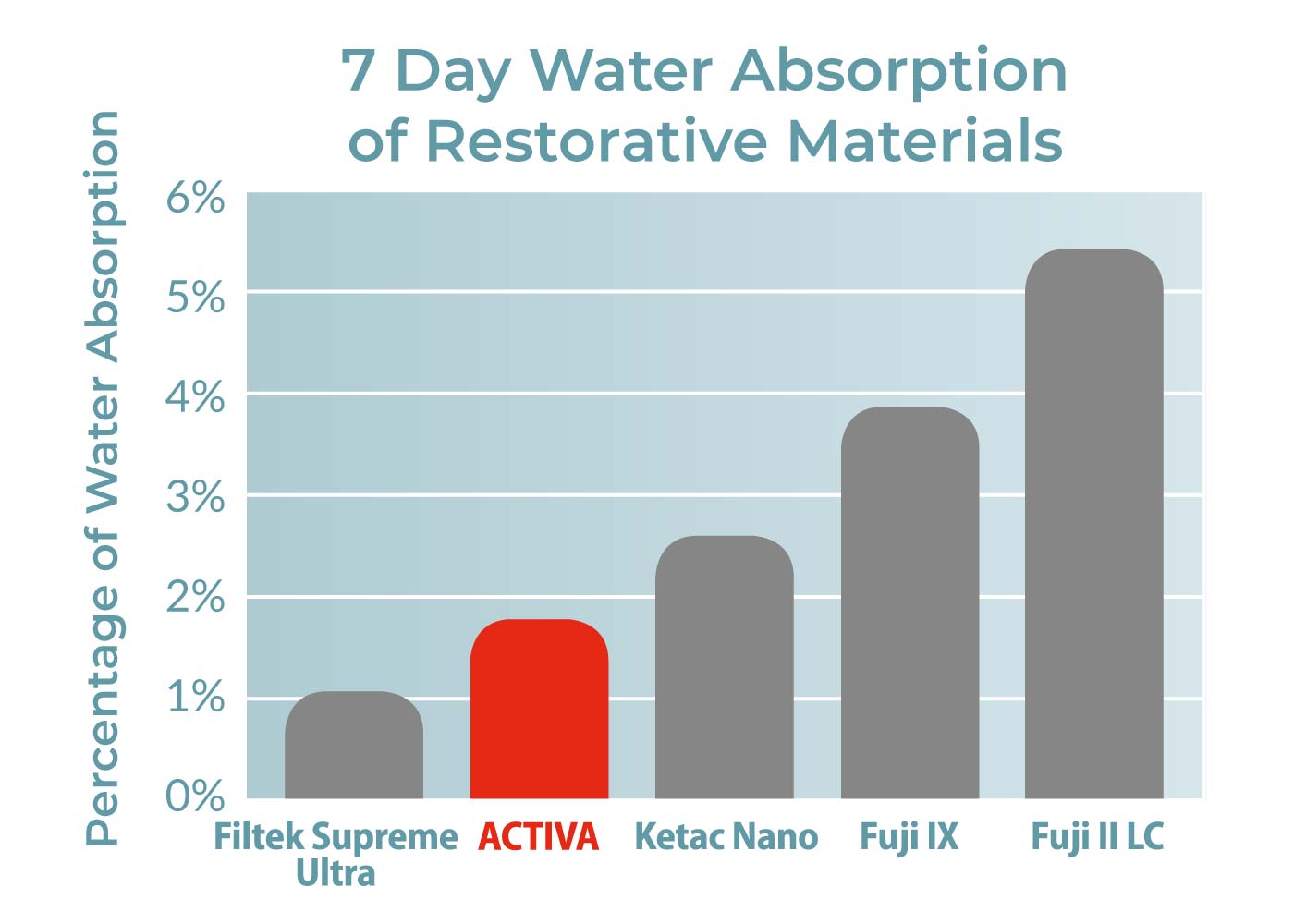
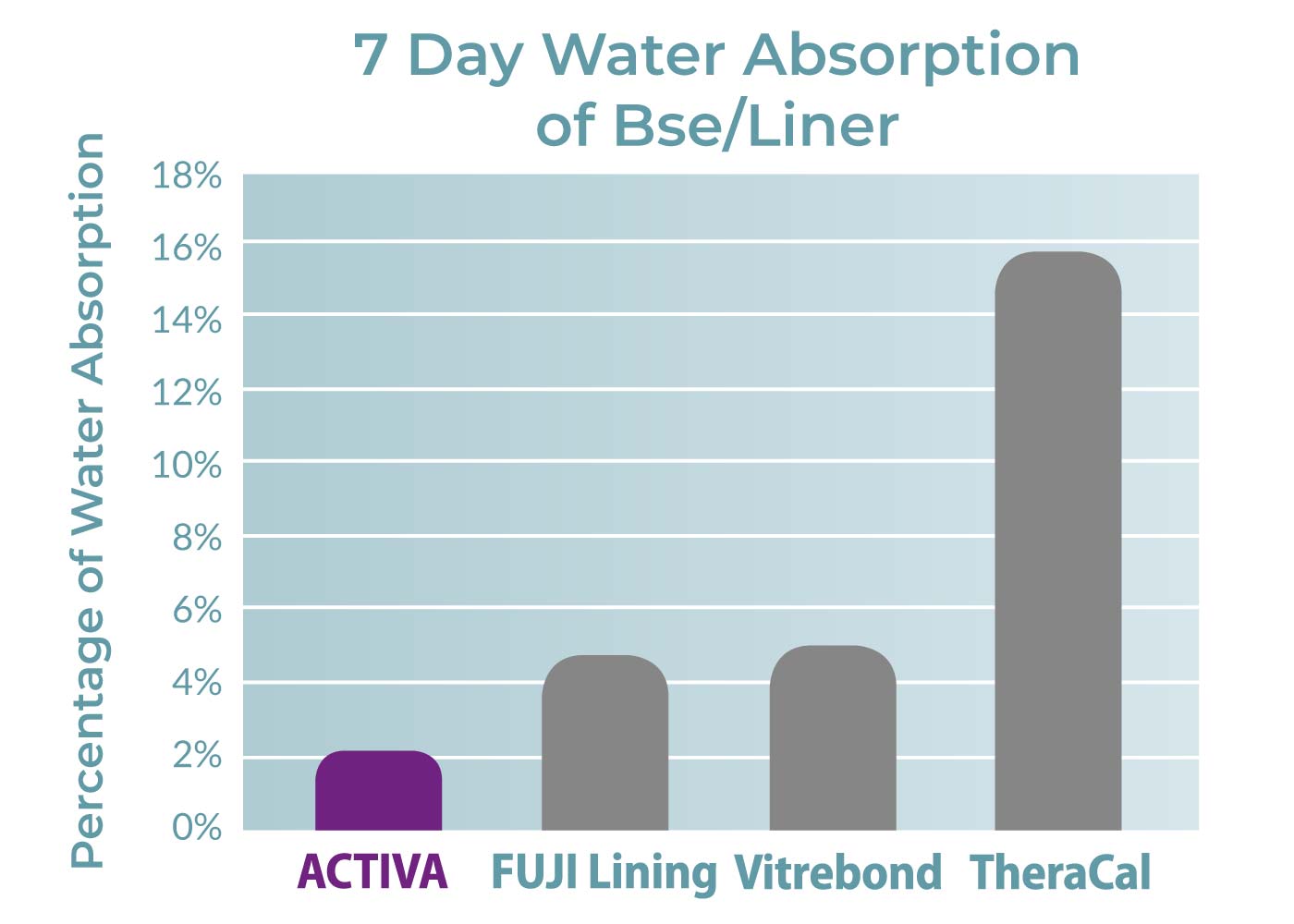
Water absorption of ACTIVA BioACTIVE-BASE/LINER is far less than RMGIs. Water absorption of TheraCal is 7 times greater than ACTIVA BioACTIVE.
ACTIVA BioACTIVE = BioACTIVE Base/Liner; Fuji Lining & Vitrebond = RMGI;
TheraCal = Resin-Modified Calcium Silicate
Fuji Lining, Vitrebond and TheraCal are trademarks of GC, 3M and Bisco respectively.
Filtek, Ketac Nano and Fuji IX/Fuji II LC are trademarks of 3M ESPE, 3M ESPE and GC respectively
Source: Pulpdent testing8,20
Water absorption of ACTIVA BioACTIVE-CEMENT compares with the leading self-adhesive cement and is far less than the RMGI and calcium aluminate-glass ionomer cements tested.
ACTIVA BioACTIVE = Bioactive Cement; RelyX Unicem Automix = Self-adhesive Cement; FujiCEM2 = RMGI; Ceramir = Calcium Aluminate-GI
Source: University testing37
RelyX, FujiCEM and Ceramir are trademarks of 3M ESPE, GC and Doxa respectively.
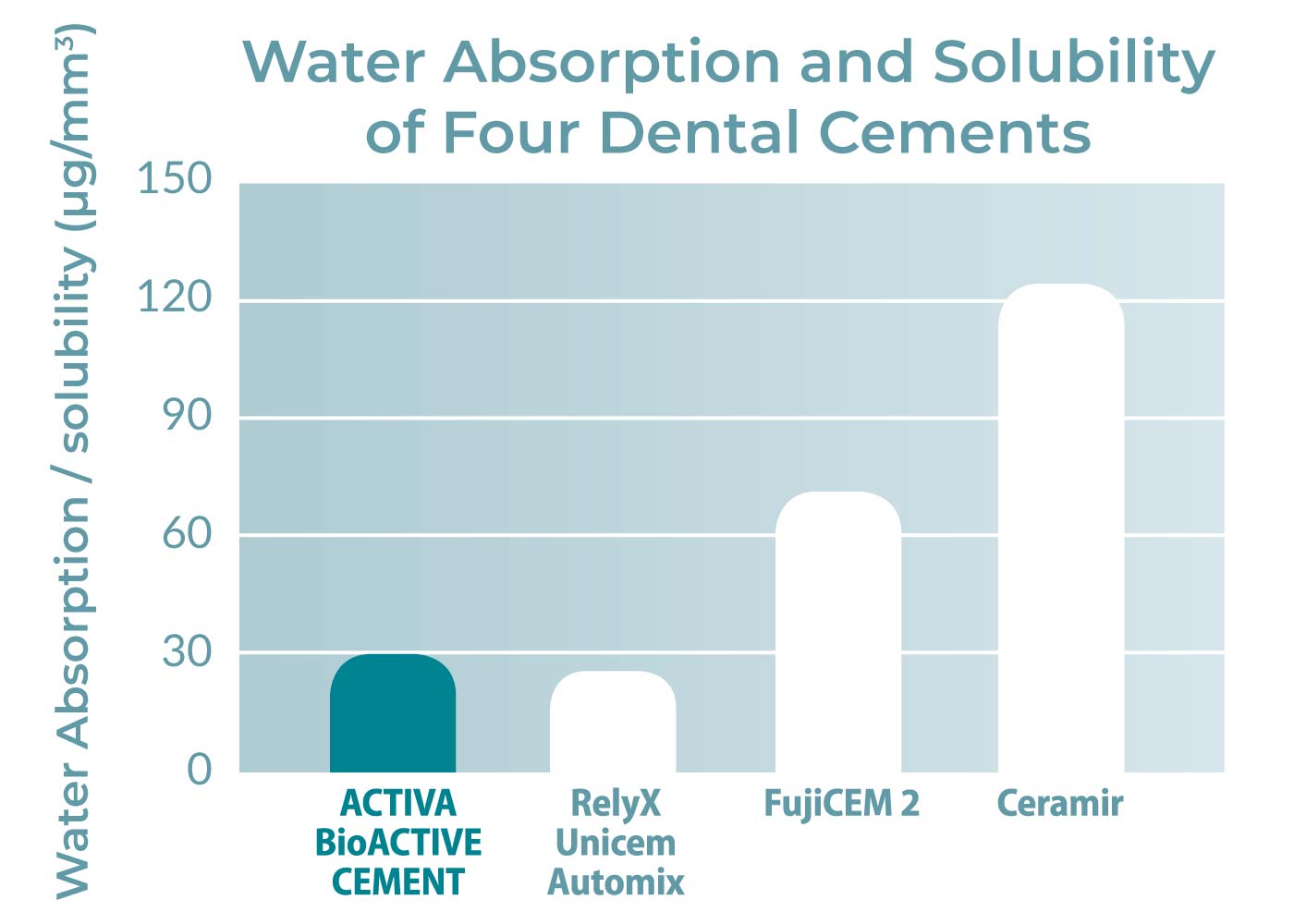
Water Solubility
Low water solubility is important for ensuring the durability and longevity of a dental material. The patented resins and reactive glass fillers in ACTIVA BioACTIVE products are balanced to deliver both bioactivity, which requires water, and durability. This unique combination of attributes, when combined with esthetics, sets ACTIVA BioACTIVE apart from all other restorative materials.
ACTIVA BioACTIVE has remarkably low water solubility that compares favorably with leading composites and is far lower than glass ionomers and RMGIs.
Filtek, Ketac Nano and Fuji are trademarks of 3M ESPE, 3M ESPE and GC respectively
Source: Pulpdent testing20
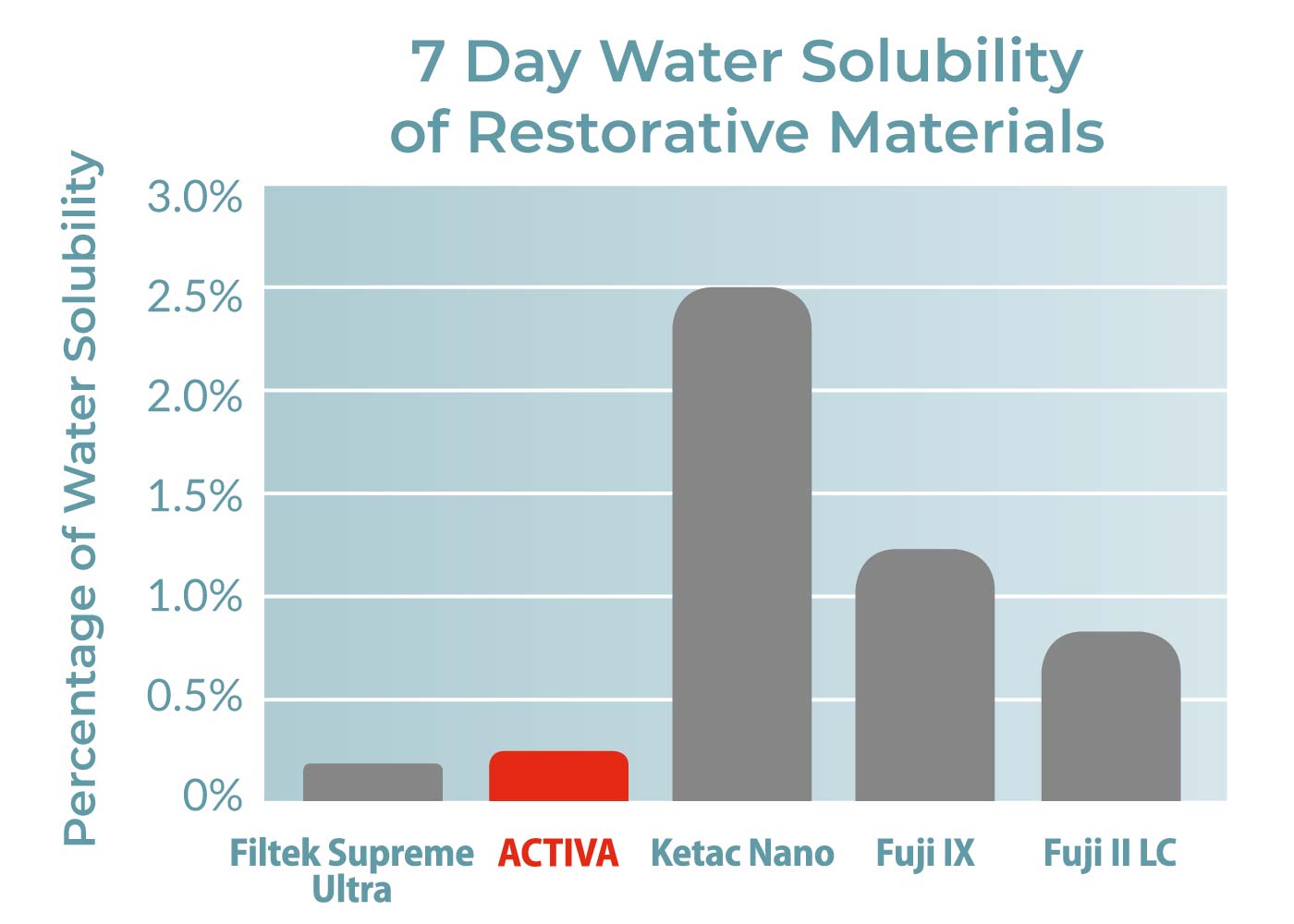
Radiopacity
The radiograph compares the radiopacity of a 1mm thick circular disk of ACTIVA BioACTIVE-RESTORATIVE to an aluminum step fixture. The steps on the fixture are in half millimeter increments, and notches on the fixture indicate the 1mm and 2mm steps.
The radiopacity of ACTIVA BioACTIVE is equivalent to 1.5mm of aluminum.
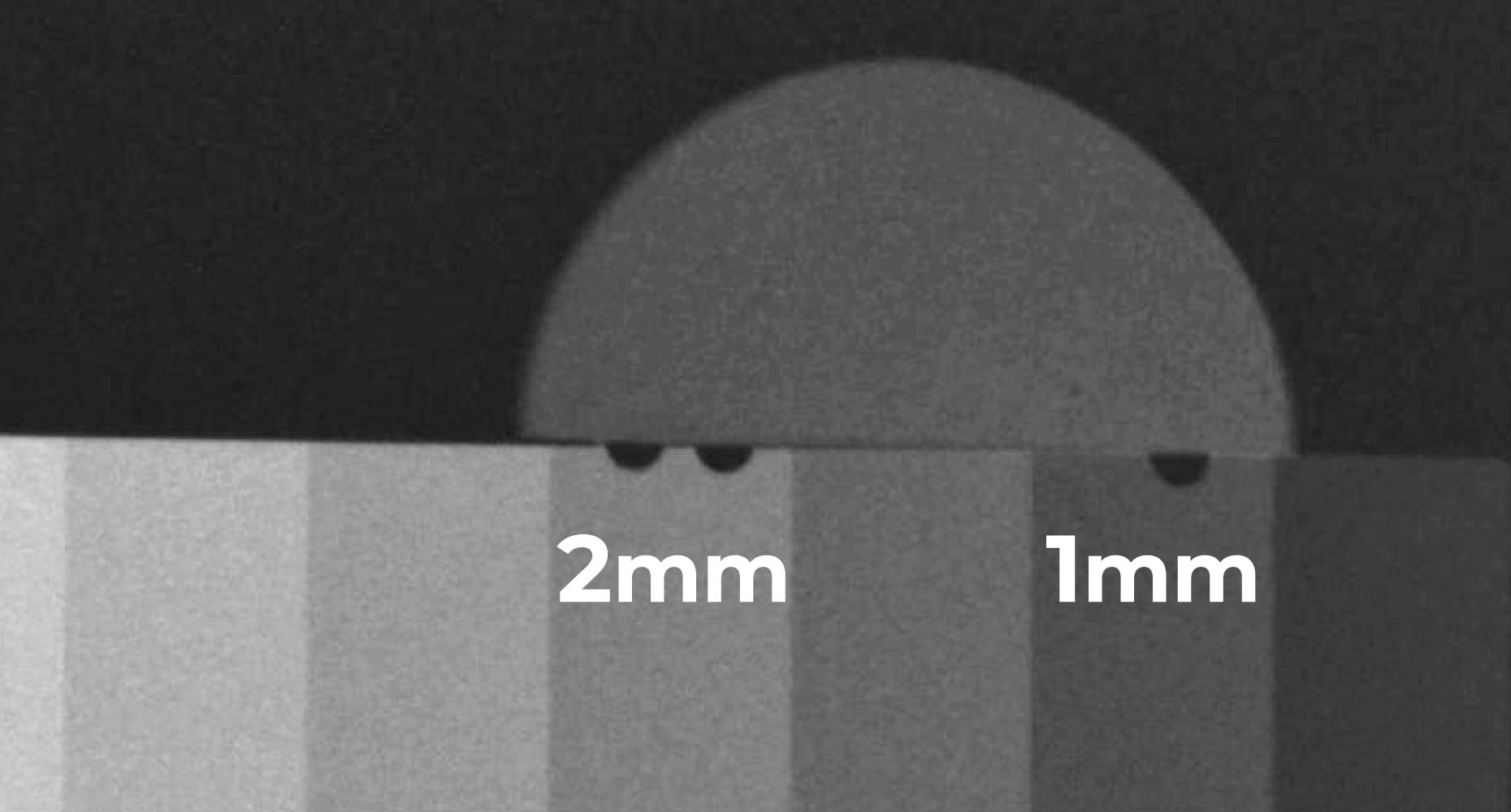
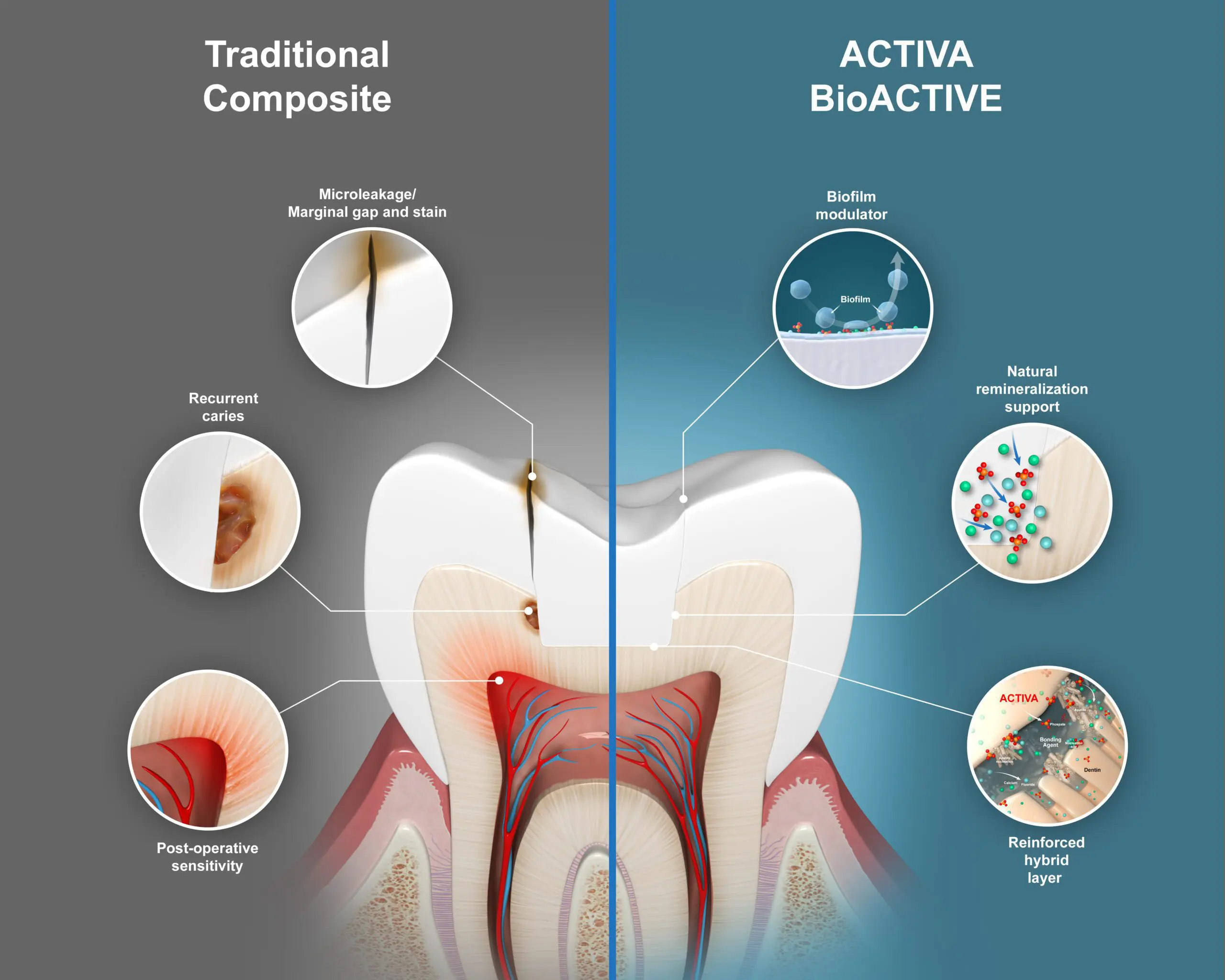
Patented SMART™ technologies inside ACTIVA BioACTIVE Bulk Flow allow it to overcome the limits of first-generation bulk-fill materials. For example, ION-X™ technology responds to pH cycles in the oral environment by releasing/recharging fluoride, calcium, and phosphate. This ionic activity supports biofilm modulation1, the natural remineralization process2, and mineral apatite formation to defend against recurrent caries3.
1Maher, Y. A., Rajeh, M. T., Hamooda, F. A., Zerain, G. O., Habis, R. M., Sulaimani, R. H., … & Abdelaleem, N. A. (2023). Evaluation of the Clinical Impact and In Vitro Antibacterial Activities of Two Bioactive Restoratives against S. mutans ATCC 25175 in Class II Carious Restorations. Nigerian Journal of Clinical Practice, 26(4), 404-411.” And another “Mah, J., Merritt, J., & Ferracane, J. (2017). Adhesion of S. mutans biofilms on potentially antimicrobial dental composites. J dent Res, 96, 2560.
2The remineralization process is a natural repair mechanism to restore the minerals again, in ionic forms, to the hydroxyapatite (HAP) crystal lattice. Source: Arifa MK, Ephraim R, Rajamani T. Recent advances in dental hard tissue remineralization: a review of literature. Intl J Clin Ped Dent. 2019:12;2:139.
3ACTIVA”™ BioACTIVE physically seals the margin of the material and tooth interface through mineral apatite formation, subsequently protecting against microleakage, the leading cause of secondary caries and recurrent decay.
Apatite Formation
ACTIVA BioACTIVE elicits a response that stimulates mineral apatite formation and natural remineralization, which is the defining requirement of bioactive materials. This process knits the restoration and the tooth together, penetrates and fills micro-gaps, reduces sensitivity, guards against secondary caries, and seals margins against microleakage and failure – nature’s way.
ACTIVA BioACTIVE responds to pH cycles and plays an active role in maintaining oral health with release and recharge of significant amounts of calcium, phosphate and fluoride. These mineral components stimulate formation of a protective/connective apatite layer and a natural bonded-seal at the material-tooth interface.
SEM Analysis of ACTIVA BioACTIVE-CEMENT after 21 Days in Saline
Compared to the no saline control, scanning electron microscope (SEM) imaging and energy-dispersive X-ray spectroscopy (EDS) after 21 days in saline shows significant increase in calcium and phosphorus ion concentrations, and decrease in carbon and silica ions, indicating that mineral apatite deposits are forming on the surface.
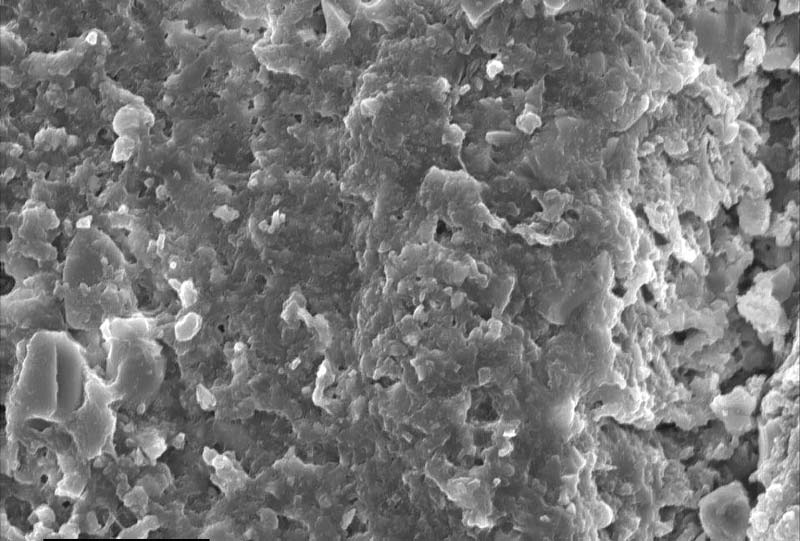
Fig 1: ACTIVA BioACTIVE-CEMENT Control, no saline 3000x

Fig 2: ACTIVA BioACTIVE-CEMENT 21 days in saline 3000x
SEM and EDS Analysis Verifies Bioactive Component
Dentin discs treated with ACTIVA BioACTIVE-CEMENT were placed in phosphate buffered solution. A layer of apatite formed and fused the dentin to ACTIVA BioACTIVE. The gap was produced when fracturing the specimen to make the SEM image. SEM and EDS analysis verifies the bioactive component in the form of hydroxyapatite and demonstrates excellent dentinal tubule penetration while consistently producing resin tags containing apatite.

Fluoride Release and Recharge
ACTIVA BioACTIVE releases and recharges with fluoride, providing long-term benefits for improved patient oral health care. University testing using fluoride ion concentration gradient diffusion methodology shows the pattern of release and recharge of ACTIVA BioACTIVE, Ketac Nano and Triage. The study concludes that “at the seven time points tested, the new bioactive material [ACTIVA BioACTIVE] has statistically greater fluoride release after recharge at 24 hours, 1 week and 3 weeks compared to the other groups tested.”
Ketac Nano and Triage are trademarks of 3M and GC respectively.
Source: University testing1
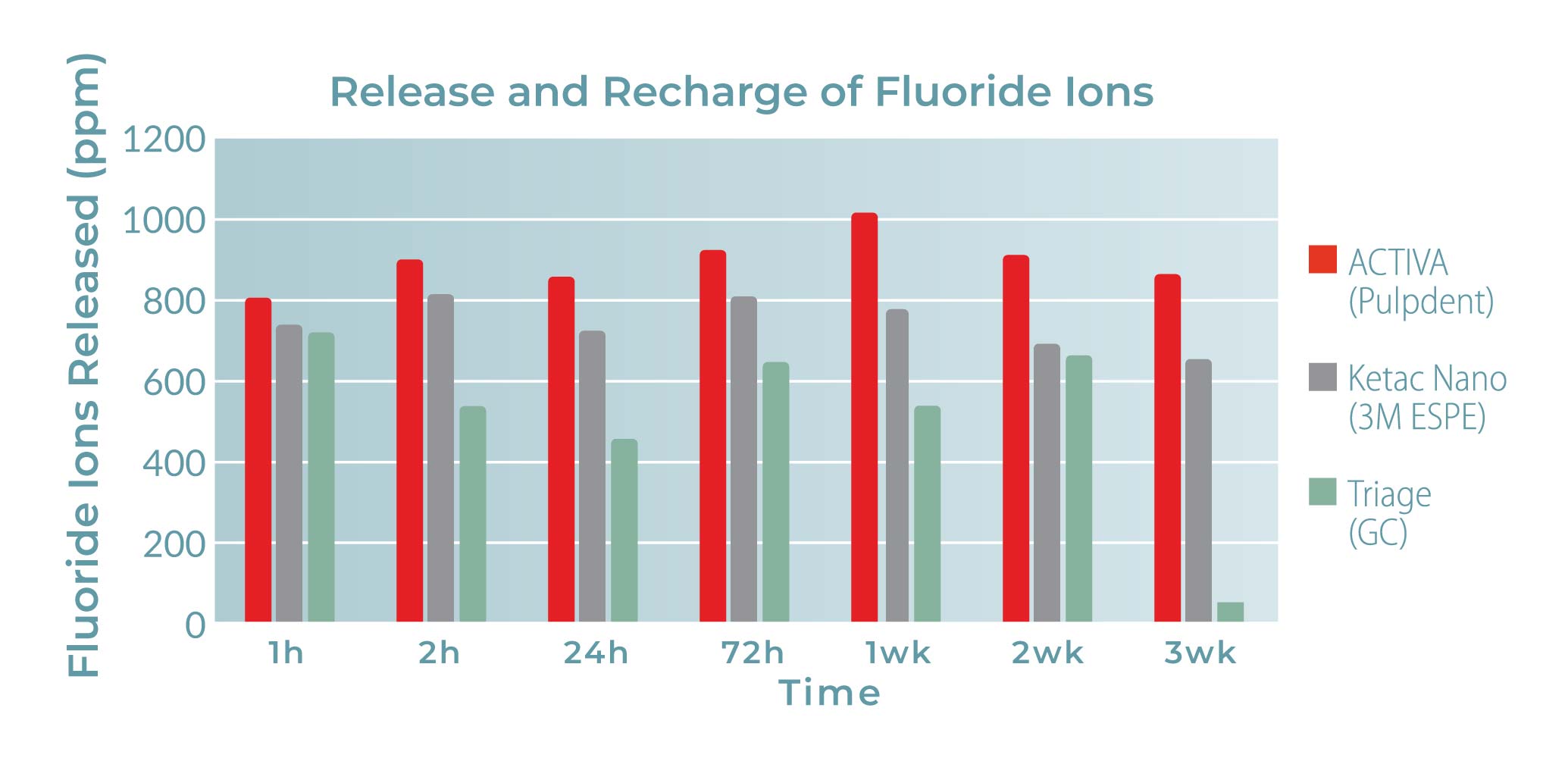
Phosphate Release
ACTIVA BioACTIVE is a “smart” material that responds to pH cycles in the mouth. During low pH demineralization cycles, ACTIVA BioACTIVE releases more phosphate. The phosphate ions can reside in the pellicle layer or saliva and are available to interact with calcium and fluoride ions during higher pH cycles.
Source: Pulpdent testing9
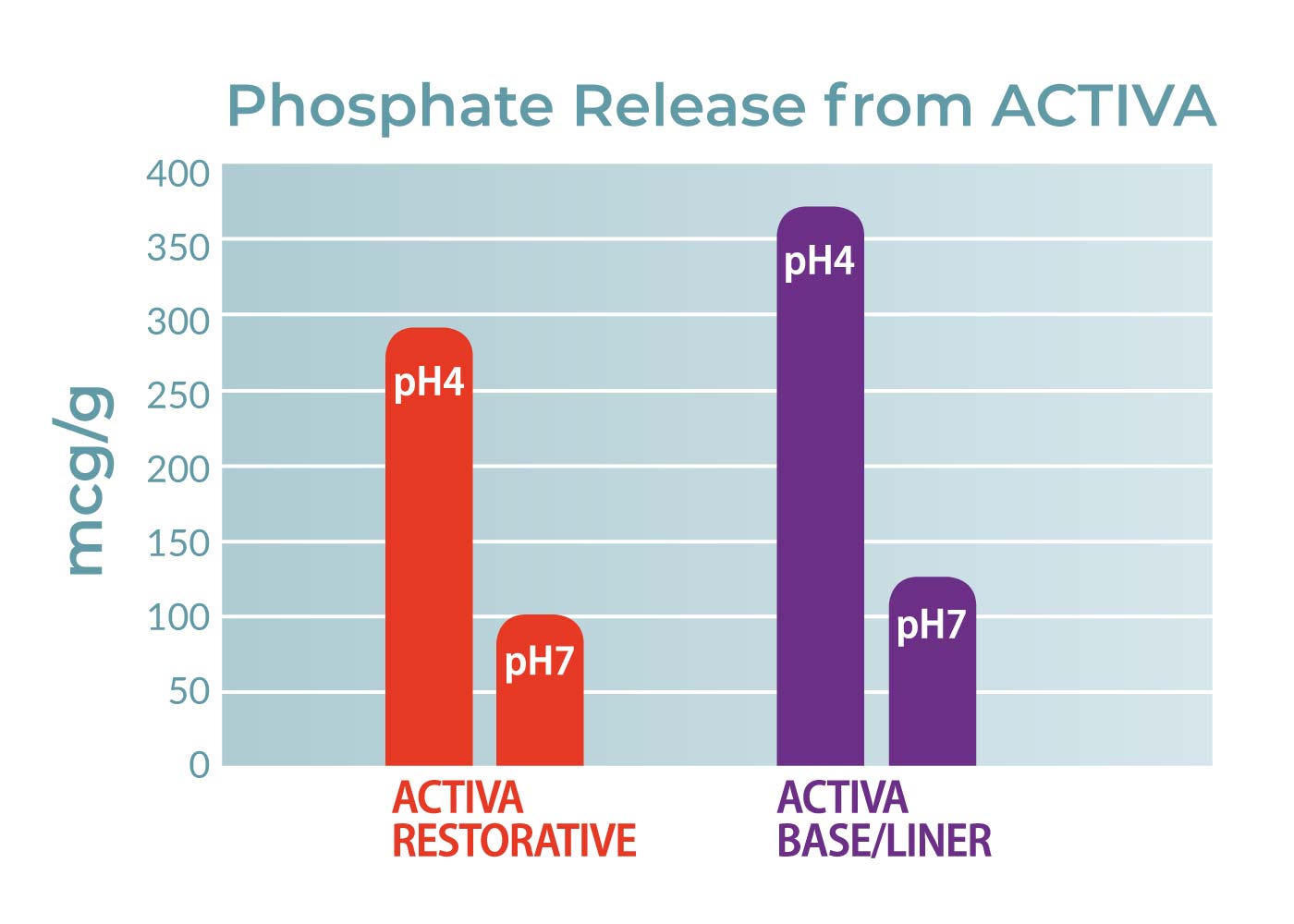
Microleakage
ACTIVA BioACTIVE-RESTORATIVE, when tested in vitro for microleakage without a bonding agent, compares favorably with leading composites tested with a bonding agent (Scotchbond Universal Adhesive, 3M ESPE).
Tetric EvoCeram. SonicFill and Filtek Supreme are trademarks of Ivoclar Vivadent, Kerr and 3M respectively.
Source: University testing16
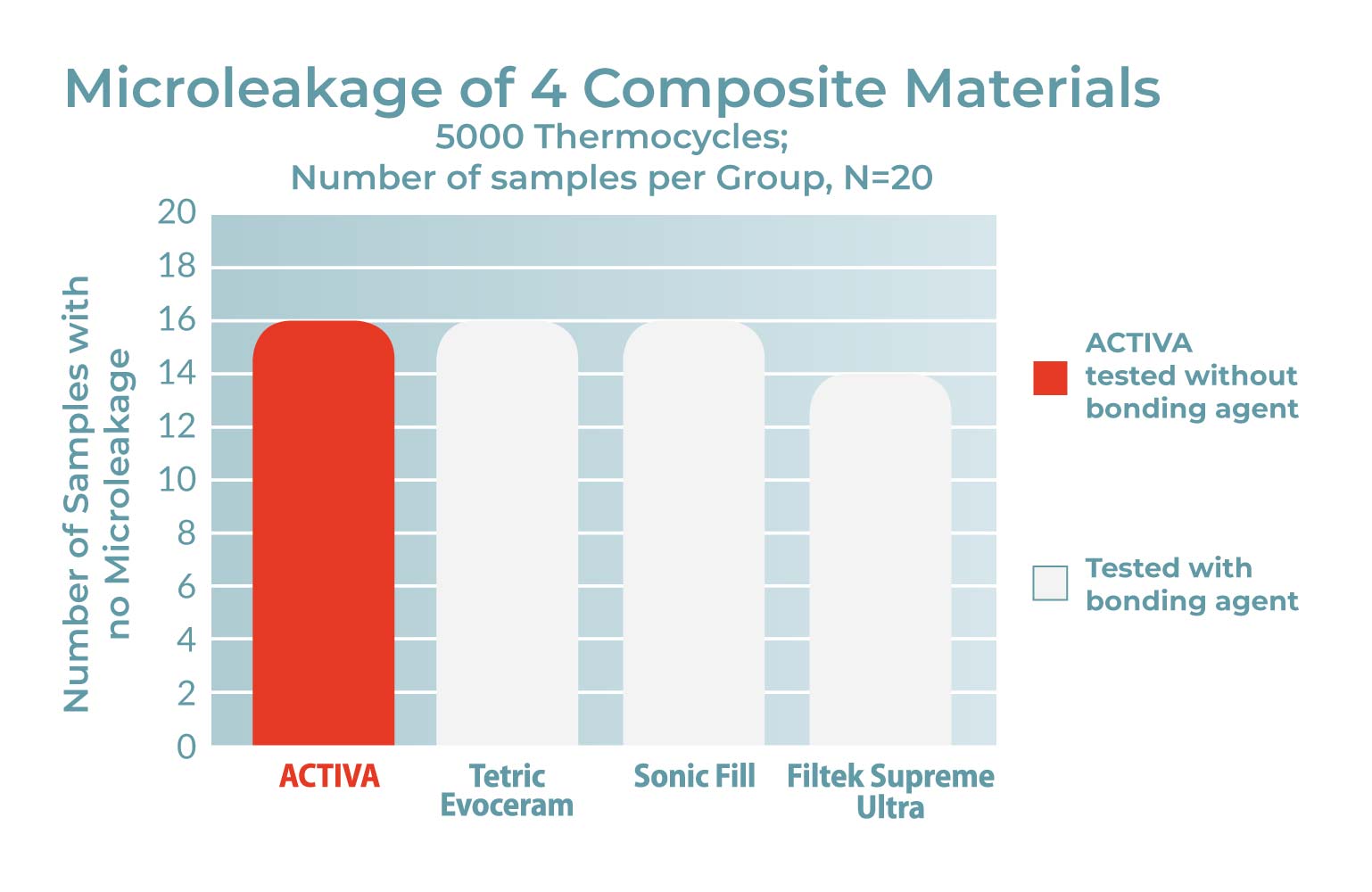
Bacterial Microleakage
ACTIVA BioACTIVE-BASE/LINER compares favorably with a leading resin modified glass ionomer material when tested for bacterial microleakage in vitro after 2,000 thermocycles.
FujiCEM is a trademark of GC. Source: Zmener O, Pameijer CH, et al.2 ACTIVA BioACTIVE-RESTORATIVE outperforms a leading RMGI when tested for bacterial microleakage in vitro after 2,000 thermocycles.

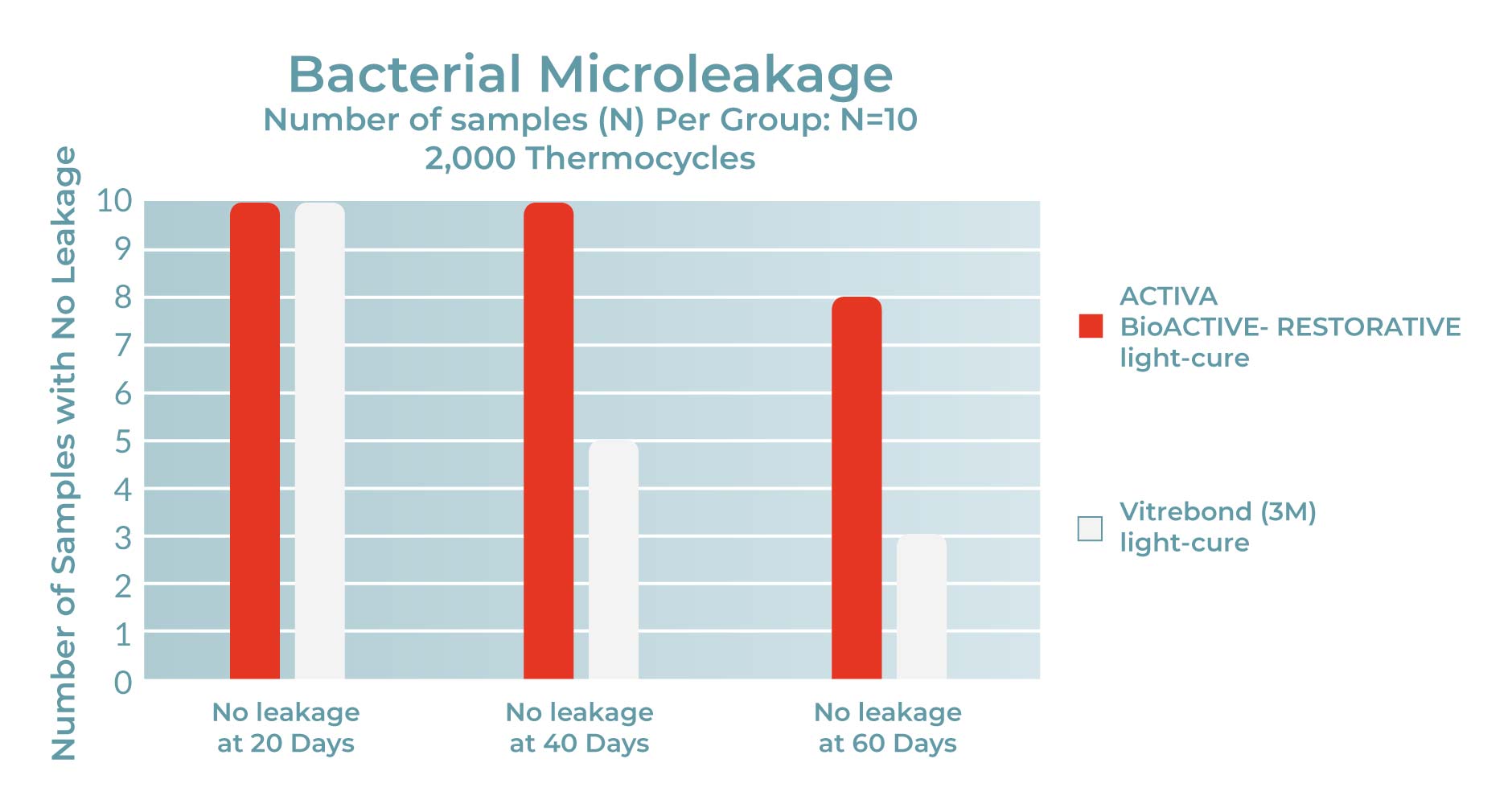
ACTIVA BioACTIVE-RESTORATIVE outperforms a leading RMGI when tested for bacterial microleakage in vitro after 2,000 thermocycles.
Vitrebond is a trademark of 3M ESPE Source: Zmener O, Pameijer CH, et al.3



